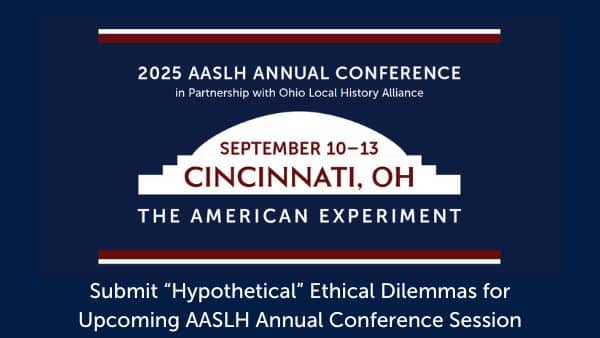Here’s my list of highlights and lessons from the Annual Meeting in Birmingham:
- Network! The sessions, offsite excursions, and vendors in the exhibit hall were all informative. The mealtime conversations were particularly valuable, by introducing me to the people behind the ideas.
- Know your community’s identity. The first session I attended was “Small Museums, Big Impact.” Presenters talked about how their exhibits and programs fit their communities’ unique needs. Now, I’m working on programs that appeal more to my town’s younger generations. This means focusing a little less on Haverhill’s identity as the “Queen Slipper City,” (the 3rd largest producer of shoes in the country in the 19th century) and more on its post-industrial future.
- It’s not about the stuff; it’s about the stories. Objects are important, but the stories that go with them are more compelling. They breathe life back into the collection and into the past. At the Small Museum Luncheon, the speaker asked if we were driven by artifacts or by ideas. Now I try to focus my tours less on the objects and more on the people who used them.
- STEM (Science, Technology, Engineering, and Math) may be hot topics now, but history is important too! During “Where’s the Humanity in STEM?” we discussed how, by making our collections relevant, we can attract funders, policy makers, and visitors. This got me thinking about creating a program on Alexander Graham Bell and others connected to our town’s history.
- Connect your historic site with the arts, and remember the 3 C’s: Concerts, Contemporary Art, and Community Involvement. Each fall at the Buttonwoods Museum, we host an art exhibition featuring works by adult and teenage students of a local artist. This year, over 300 people came for the reception; even more came at other times to view it. Now, we’re looking into hosting more exhibits from community groups.
- It’s ok to admit you don’t know much about parts of your collection. During the session, “Practical Solutions for Rethinking our Collections,” we discussed identifying unknowns in our collections. You can use social media to crowd source, or you can tap the expertise of special interest clubs. Every participant benefits from this approach; the museum staff learns what the mystery object is, and the audience gets an insider’s view of the organization.
- Many activities address issues faced by workers in small museums. The sessions, the luncheon, and the get-together before the first day of the conference helped reinforce a sense of community among the small museum professionals. Because of this, I know that I’ll continue my involvement with AASLH, particularly with those in the small museum community.
Thank you so much to AASLH, the Small Museums Scholarship Committee, and the financial supporters for giving me the opportunity to attend! Everything I learned will contribute to a promising future for both our museum and our community.
Kaleigh Paré is the Program Coordinator for the Buttonwoods Museum in Haverhill, MA. With a bachelor’s degree in anthropology and history from Bates College, she is now working on her master’s thesis in museum studies at the Harvard University Extension School. Standing at 4’10”, she is truly a small museum professional!




